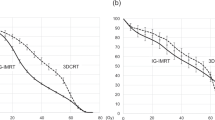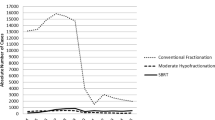Abstract
Background
While moderately hypofractionated radiotherapy (MHRT) for prostate cancer (PC) is commonly delivered by intensity modulated radiation therapy, IMRT has not been prospectively compared to three-dimensional conformal radiotherapy (3D-CRT) in this context. We conducted a secondary analysis of the phase III RTOG 0415 trial comparing survival and toxicity outcomes for low-risk PC following MHRT with IMRT versus 3D-CRT.
Methods
RTOG 0415 was a phase III, non-inferiority trial randomizing low-risk PC patients to either MHRT or conventionally fractionated radiation with stratification by RT technique. A secondary analysis for differences in overall survival (OS), biochemical recurrence free survival (BRFS), or toxicity by EPIC scores and Common Terminology Criteria for Adverse Events (CTCAE) was performed.
Results
1079 patients received the allocated intervention with a median follow up of 5.8 years. 79.1% of patients were treated with IMRT and radiation technique was balanced between arms. Across all patients, RT technique was not associated with significant differences in BRFS, OS, or rates of acute and late toxicities. For patients completing MHRT, there was a difference in the late GU toxicity distribution between 3D-CRT and IMRT but no difference in late grade 2 or greater GU or GI toxicity. Stratifying patients by RT technique and fractionation, no significant differences were observed in the minimal clinically important difference (MCID) in EPIC urinary and bowel scores following RT.
Conclusions
RT technique did not impact clinical outcomes following MHRT for low-risk PC. Despite different late GU toxicity distributions in patients treated with MHRT by IMRT or 3D-CRT, there was no difference in late Grade 2 or greater GU or GI toxicity or patient reported toxicity. Increases in late GU and GI toxicity following MHRT compared to CFRT, as demonstrated in the initial publication of RTOG 0415, do not appear related to a 3D-CRT treatment technique.
This is a preview of subscription content, access via your institution
Access options
Subscribe to this journal
Receive 4 print issues and online access
$259.00 per year
only $64.75 per issue
Buy this article
- Purchase on Springer Link
- Instant access to full article PDF
Prices may be subject to local taxes which are calculated during checkout

Similar content being viewed by others
Data availability
This manuscript was prepared using data from the Datasets NCT00331773-D1, NCT00331773-D2 from the NCTN/NCORP Data Archive of the National Cancer Institute’s (NCI’s) National Clinical Trials Network (NCTN). Data were originally collected from clinical trial NCT number NCT00331773 A Phase III Randomized Study of Hypofractionated 3D-CRT/MRT Versus Conventionally Fractionated 3D-CRT/MRT in Patients With Favorable-Risk Prostate Cancer. All analyses and conclusions in this manuscript are the sole responsibility of the authors and do not necessarily reflect the opinions or views of the clinical trial investigators, the NCTN, the NCORP, or the NCI. Code is available at request from the senior author.
References
Siegel RL, Miller KD, Jemal A. Cancer statistics, 2020. CA Cancer J Clin. 2020;70:7–30.
Cabrera AR, Lee WR. Hypofractionation for clinically localized prostate cancer. Semin Radiat Oncol. 2013;23:191–7.
Morgan SC, Hoffman K, Loblaw DA, Buyyounouski MK, Patton C, Barocas D, et al. Hypofractionated radiation therapy for localized prostate cancer: Executive summary of an ASTRO, ASCO and AUA evidence-based guideline. J Urol. 2019;201:528–34.
Lee WR, Dignam JJ, Amin MB, Bruner DW, Low D, Swanson GP, et al. Randomized phase III noninferiority study comparing two radiotherapy fractionation schedules in patients with low-risk prostate cancer. J Clin Oncol. 2016;34:2325–32.
Dearnaley D, Syndikus I, Mossop H, Khoo V, Birtle A, Bloomfield D, et al. Conventional versus hypofractionated high-dose intensity-modulated radiotherapy for prostate cancer: 5-year outcomes of the randomised, non-inferiority, phase 3 CHHiP trial. Lancet Oncol. 2016;17:1047–60.
Catton CN, Lukka H, Gu C-S, Martin JM, Supiot S, Chung PWM, et al. Randomized trial of a hypofractionated radiation regimen for the treatment of localized prostate cancer. J Clin Oncol. 2017;35:1884–90.
Arcangeli G, Saracino B, Arcangeli S, Gomellini S, Petrongari MG, Sanguineti G, et al. Moderate hypofractionation in high-risk, organ-confined prostate cancer: Final results of a phase III randomized trial. J Clin Oncol. 2017;35:1891–7.
Incrocci L, Wortel RC, Alemayehu WG, Aluwini S, Schimmel E, Krol S, et al. Hypofractionated versus conventionally fractionated radiotherapy for patients with localised prostate cancer (HYPRO): final efficacy results from a randomised, multicentre, open-label, phase 3 trial. Lancet Oncol. 2016;17:1061–9.
Hoffman KE, Voong KR, Levy LB, Allen PK, Choi S, Schlembach PJ, et al. Randomized trial of hypofractionated, dose-escalated, intensity-modulated radiation therapy (IMRT) versus conventionally fractionated IMRT for localized prostate cancer. J Clin Oncol. 2018;36:2943–9.
Pollack A, Walker G, Horwitz EM, Price R, Feigenberg S, Konski AA, et al. Randomized trial of hypofractionated external-beam radiotherapy for prostate cancer. J Clin Oncol. 2013;31:3860–8.
Voong KR, Lal LS, Kuban DA, Pugh TJ, Swint JM, Godby J, et al. Long-term economic value of hypofractionated prostate radiation: Secondary analysis of a randomized trial. Adv Radiat Oncol. 2017;2:249–58.
Stokes WA, Kavanagh BD, Raben D, Pugh TJ. Implementation of hypofractionated prostate radiation therapy in the United States: A National Cancer Database analysis. Pract. Radiat Oncol. 2017;7:270–8.
Jaworski L, Dominello MM, Heimburger DK, Mancini BR Jr, Boike TP, Schipper M, et al. Contemporary practice patterns for intact and post-operative prostate cancer: results from a statewide collaborative. Int J Radiat Oncol Biol Phys. 2019;105:E282.
Sharma NK, Li T, Chen DY, Pollack A, Horwitz EM, Buyyounouski MK. Intensity modulated radiation therapy reduces gastrointestinal toxicity in patients treated with androgen deprivation therapy for prostate cancer. Int J Radiat Oncol Biol Phys. 2007;69:S10.
Zelefsky MJ, Fuks Z, Happersett L, Lee HJ, Ling CC, Burman CM, et al. Clinical experience with intensity modulated radiation therapy (IMRT) in prostate cancer. Radiother Oncol. 2000;55:241–9.
Luxton G, Hancock SL, Boyer AL. Dosimetry and radiobiologic model comparison of IMRT and 3D conformal radiotherapy in treatment of carcinoma of the prostate. Int J Radiat Oncol Biol Phys. 2004;59:267–84.
Fenoglietto P, Laliberte B, Allaw A, Ailleres N, Idri K, Hay MH, et al. Persistently better treatment planning results of intensity-modulated (IMRT) over conformal radiotherapy (3D-CRT) in prostate cancer patients with significant variation of clinical target volume and/or organs-at-risk. Radiother Oncol. 2008;88:77–87.
Wei JT, Dunn RL, Litwin MS, Sandler HM, Sanda MG. Development and validation of the expanded prostate cancer index composite (EPIC) for comprehensive assessment of health-related quality of life in men with prostate cancer. Urology. 2000;56:899–905.
Skolarus TA, Dunn RL, Sanda MG, Chang P, Greenfield TK, Litwin MS, et al. Minimally important difference for the Expanded Prostate Cancer Index Composite Short Form. Urology. 2015;85:101–5.
Roach M 3rd, Hanks G, Thames H Jr, Schellhammer P, Shipley WU, Sokol GH, et al. Defining biochemical failure following radiotherapy with or without hormonal therapy in men with clinically localized prostate cancer: recommendations of the RTOG-ASTRO Phoenix Consensus Conference. Int J Radiat Oncol Biol Phys. 2006;65:965–74.
Neal DE, Metcalfe C, Donovan JL, Lane JA, Davis M, Young GJ, et al. Ten-year mortality, disease progression, and treatment-related side effects in men with localised prostate cancer from the protect randomised controlled trial according to treatment received. Eur Urol. 2020;77:320–30.
Zelefsky MJ, Chan H, Hunt M, Yamada Y, Shippy AM, Amols H. Long-term outcome of high dose intensity modulated radiation therapy for patients with clinically localized prostate cancer. J Urol. 2006;176:1415–9.
Al-Mamgani A, Heemsbergen WD, Peeters STH, Lebesque JV. Role of intensity-modulated radiotherapy in reducing toxicity in dose escalation for localized prostate cancer. Int J Radiat Oncol Biol Phys. 2009;73:685–91.
Buckey C, Swanson G, Stathakis S, Papanikolaou N. Dosimetric comparison between 3D conformal and intensity-modulated radiation therapy for prostate cancer. J Radiother Pr. 2010;9:77–85.
Kneebone A, Gebski V, Hogendoorn N, Turner S. A randomized trial evaluating rigid immobilization for pelvic irradiation. Int J Radiat Oncol Biol Phys. 2003;56:1105–11.
Lee JA, Kim CY, Park YJ, Yoon WS, Lee NK, Yang DS. Interfractional variability in intensity-modulated radiotherapy of prostate cancer with or without thermoplastic pelvic immobilization. Strahlenther Onkol. 2014;190:94–9.
Ryu JK, Winter K, Michalski JM, Purdy JA, Markoe AM, Earle JD, et al. Interim report of toxicity from 3D conformal radiation therapy (3D-CRT) for prostate cancer on 3DOG/RTOG 9406, level III (79.2 Gy). Int J Radiat Oncol Biol Phys. 2002;54:1036–46.
Michalski JM, Winter K, Purdy JA, Parliament M, Wong H, Perez CA, et al. Toxicity after three-dimensional radiotherapy for prostate cancer on RTOG 9406 dose Level V. Int J Radiat Oncol Biol Phys. 2005;62:706–13.
Yoo S, Wu QJ, Lee WR, Yin F-F. Radiotherapy treatment plans with RapidArc for prostate cancer involving seminal vesicles and lymph nodes. Int J Radiat Oncol Biol Phys. 2010;76:935–42.
Crijns W, Budiharto T, Defraene G, Verstraete J, Depuydt T, Haustermans K, et al. IMRT-based optimization approaches for volumetric modulated single arc radiotherapy planning. Radiother Oncol. 2010;95:149–52.
Pollack A, Hanlon A, Horwitz EM, Feigenberg S, Uzzo RG, Price RA. Radiation therapy dose escalation for prostate cancer: a rationale for IMRT. World J Urol. 2003;21:200–8.
Thor M, Deasy JO, Paulus R, Robert Lee W, Amin MB, Bruner DW, et al. Tolerance doses for late adverse events after hypofractionated radiotherapy for prostate cancer on trial NRG Oncology/RTOG 0415. Radiother Oncol. 2019;135:19–24.
Ghadjar P, Zelefsky MJ, Spratt DE. Munck af Rosenschöld P, Oh JH, Hunt M, et al. Impact of dose to the bladder trigone on long-term urinary function after high-dose intensity modulated radiation therapy for localized prostate cancer. Int J Radiat Oncol Biol Phys. 2014;88:339–44.
Bentzen SM, Constine LS, Deasy JO, Eisbruch A, Jackson A, Marks LB, et al. Quantitative Analyses of Normal Tissue Effects in the Clinic (QUANTEC): an introduction to the scientific issues. Int J Radiat Oncol Biol Phys. 2010;76:S3–9.
Michalski JM, Gay H, Jackson A, Tucker SL, Deasy JO. Radiation dose-volume effects in radiation-induced rectal injury. Int J Radiat Oncol Biol Phys. 2010;76:S123–9.
Viswanathan AN, Yorke ED, Marks LB, Eifel PJ, Shipley WU. Radiation dose–volume effects of the urinary bladder. Int J Radiat Oncol Biol Phys. 2010;76:S116–22.
Roach M 3rd, Nam J, Gagliardi G, El Naqa I, Deasy JO, Marks LB. Radiation dose-volume effects and the penile bulb. Int J Radiat Oncol Biol Phys. 2010;76:S130–4.
Yeoh EE, Botten RJ, Butters J, Di Matteo AC, Holloway RH, Fowler J. Hypofractionated versus conventionally fractionated radiotherapy for prostate carcinoma: final results of phase III randomized trial. Int J Radiat Oncol Biol Phys. 2011;81:1271–8.
Lukka H, Hayter C, Julian JA, Warde P, Morris WJ, Gospodarowicz M, et al. Randomized trial comparing two fractionation schedules for patients with localized prostate cancer. J Clin Oncol. 2005;23:6132–8.
LaRiviere MJ, Zhu TC, Christodouleas JP. Important technical considerations for implementing the ASTRO/ASCO/AUA prostate cancer hypofractionated radiation guideline. Pract. Radiat Oncol. 2019;9:197–9.
Bruner DW, Pugh SL, Lee WR, Hall WA, Dignam JJ, Low D, et al. Quality of life in patients with low-risk prostate cancer treated with hypofractionated vs conventional radiotherapy: A phase 3 randomized clinical trial. JAMA Oncol. 2019;5:664–70.
Author information
Authors and Affiliations
Contributions
DJC: formal analysis, writing-original draft, review and editing, investigation. JKS and WRL: investigation, supervision, writing—review and editing. MJB: conceptualization, investigation, formal analysis, writing—review and editing.
Corresponding author
Ethics declarations
Competing interests
The authors declare no competing interests.
Additional information
Publisher’s note Springer Nature remains neutral with regard to jurisdictional claims in published maps and institutional affiliations.
Rights and permissions
Springer Nature or its licensor (e.g. a society or other partner) holds exclusive rights to this article under a publishing agreement with the author(s) or other rightsholder(s); author self-archiving of the accepted manuscript version of this article is solely governed by the terms of such publishing agreement and applicable law.
About this article
Cite this article
Carpenter, D.J., Salama, J.K., Lee, W.R. et al. Radiation technique and outcomes following moderately hypofractionated treatment of low risk prostate cancer: a secondary analysis of RTOG 0415. Prostate Cancer Prostatic Dis 27, 95–102 (2024). https://doi.org/10.1038/s41391-023-00653-7
Received:
Revised:
Accepted:
Published:
Issue Date:
DOI: https://doi.org/10.1038/s41391-023-00653-7



